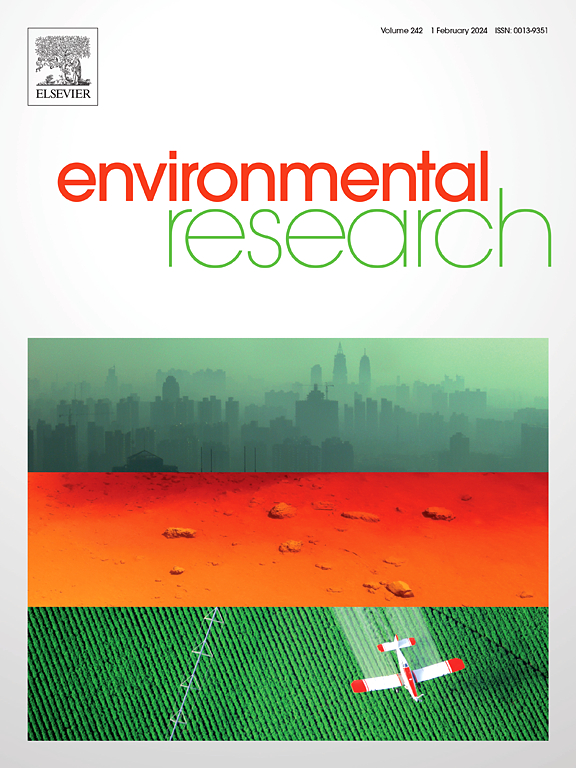河床底物在N2O和CH4排放中的作用:来自生物膜宏基因组分析的见解
IF 7.7
2区 环境科学与生态学
Q1 ENVIRONMENTAL SCIENCES
引用次数: 0
摘要
河床底物是N2O和CH4排放的关键,有功能微生物附着。然而,底物的作用仍有待充分了解。本研究对某山地河流10个断面不同直径和大小不均一的河床底物进行了N2O和CH4排放监测,并收集了附着生物膜。与全球范围相比,N2O的水-气交换速率适中(−2.34 ~ 29.2 μg/m2/h), CH4的排放速度较快(−2.58 ~ 35.2 mg/m2/h)。宏基因组分析发现,中径组(2-100 mm)的nirS和fmdA基因丰度显著高于反硝化和氢营养化产甲烷过程的催化剂,这意味着N2O和CH4的排放量更高。与此同时,nirS和nirK基因的丰度在低尺寸异质性组中显著升高,促进了N2O的释放。相比之下,在甲烷生成过程中至关重要的ftr、pta、ackA和ACS基因的丰度在小尺寸异质性组中显著降低,抑制了CH4的释放。对于N2O的产生,硝化过程以Nocardioides和plananctomycetes物种为主,反硝化过程以Tabrizicola和Rhodobacteraceae物种为主,异化硝态氮还原为铵态氮的过程以Leptospiraceae物种为主。相比之下,CH4主要由Pirellula和Proteobacteria菌种分别通过氢营养、醋酸破碎和甲基营养产甲烷产生。一个结构方程模型表明,对于山地河流N2O或CH4排放,基质物理性质与水生营养物质浓度同等甚至更重要。本文章由计算机程序翻译,如有差异,请以英文原文为准。

The role of riverbed substrates in N2O and CH4 emission: Insights from metagenomic analysis of epilithic biofilms
Riverbed substrates are critical in N2O and CH4 emission with functional microbes adhering to them. However, the role of substrates remains to be fully understood. This study monitors N2O and CH4 emission and collects epilithic biofilms on riverbed substrates with various diameters and size heterogeneity from 10 sections along a mountain river. Compared with the global range, moderate water-air exchange rates of N2O (−2.34–29.2 μg/m2/h) and rapid CH4 emission (−2.58–35.2 mg/m2/h) are observed. Based on metagenomic analysis, the abundances of nirS and fmdA genes, which encode catalysts in the denitrification and the hydrogenotrophic methanogenesis process, are found to be significantly higher in the medium diameter group (2–100 mm), implying higher N2O and CH4 emission. Meanwhile, the abundance of nirS and nirK genes, which are key to N2O production, is significantly higher in the low size heterogeneity group, promoting N2O release. In contrast, the abundance of ftr, pta,ackA and ACS genes critical in the methanogenesis processes are significantly lower in the low size heterogeneity group, inhibiting CH4 emission. For N2O production, the nitrification process is found to be dominated by species of Nocardioides and Planctomycetales, denitrification process by species of Tabrizicola and Rhodobacteraceae, and dissimilatory nitrate reduction to ammonium process by Leptospiraceae species. In contrast, CH4 is mainly generated by species of Pirellula and Proteobacteria through hydrogenotrophic, acetoclastic and methylotrophic methanogenesis respectively. A structural equation model indicated that substrate physical properties are equally or even more important as/than the aquatic nutrients concentration for N2O or CH4 emission in mountain rivers.
求助全文
通过发布文献求助,成功后即可免费获取论文全文。
去求助
来源期刊

Environmental Research
环境科学-公共卫生、环境卫生与职业卫生
CiteScore
12.60
自引率
8.40%
发文量
2480
审稿时长
4.7 months
期刊介绍:
The Environmental Research journal presents a broad range of interdisciplinary research, focused on addressing worldwide environmental concerns and featuring innovative findings. Our publication strives to explore relevant anthropogenic issues across various environmental sectors, showcasing practical applications in real-life settings.
 求助内容:
求助内容: 应助结果提醒方式:
应助结果提醒方式:


